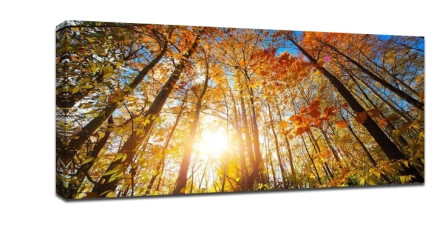Tips for autumn photography
Autumn is a magical season for photographers. The crisp air, golden leaves, and soft sunlight create perfect conditions to capture stunning images. Whether you’re an amateur or a seasoned photographer, autumn offers endless opportunities to explore your creativity. One way to display your autumn masterpieces beautifully is through floating frame canvas prints, which add depth and elegance to your photography, making your fall memories last forever.
1. Embrace the Golden Hour
The “golden hour” — the hour after sunrise and before sunset — is ideal for autumn photography. During this time, sunlight is softer and warmer, highlighting the reds, oranges, and yellows of fall foliage. Try shooting landscapes with the sun low in the sky to create long shadows and natural contrast, giving your images depth and dimension.
2. Look for Unique Perspectives
Autumn photography isn’t just about capturing trees. Look for unique angles and perspectives to make your shots stand out. For example, shoot through fallen leaves on the ground, capture reflections in puddles or lakes, or use a low angle to highlight the texture of autumn leaves. Experimenting with perspective can make even ordinary scenes feel extraordinary.
3. Focus on Details
While sweeping landscapes are captivating, don’t forget the small details. Close-up shots of acorns, fallen leaves, or a single branch with colorful leaves can evoke the essence of autumn in a simple yet powerful way. Macro photography allows you to showcase textures and patterns that might otherwise go unnoticed. These detailed images are perfect for display as floating frame canvas prints, creating a sophisticated focal point in any room.
4. Use Natural Frames
Autumn provides natural frames in the form of arching branches, tunnels of trees, or window-like gaps in the foliage. Composing your shots with these frames draws attention to your subject and adds depth to your photos. This technique works beautifully for both landscape and portrait photography, and it gives your final prints a professional, gallery-quality appearance.
5. Master the Colors
Fall colors are rich and vibrant, but they can also be tricky to photograph accurately. To capture the true essence of autumn, adjust your camera’s white balance and consider using a polarizing filter to reduce glare and enhance color saturation. Don’t be afraid to slightly underexpose your shots — this can intensify the warm tones of the leaves. When printing your photos on floating frame canvas prints, these color adjustments ensure that your artwork pops and maintains its visual impact over time.
6. Play with Weather Conditions
Autumn weather can be unpredictable, but it also offers unique photographic opportunities. Misty mornings, light rain, or overcast skies can add mood and atmosphere to your photos. Fog can create a dreamy, ethereal effect, while wet leaves reflect light beautifully, adding an extra dimension to your images. Experimenting with different conditions can help you develop a versatile autumn photography portfolio.
7. Include People or Animals
Adding a human or animal element can bring life and scale to your autumn scenes. A child playing in a pile of leaves, a person walking down a leaf-covered path, or wildlife foraging can make your photos more engaging. These storytelling elements create emotional connections for viewers and make your floating frame canvas prints even more meaningful when displayed at home.
8. Keep Your Gear Ready
Autumn can be unpredictable, so always be prepared. Carry extra batteries, memory cards, and protective gear for your camera. Layered clothing will keep you comfortable during long shoots outdoors. Having your gear ready ensures you won’t miss fleeting moments like the perfect sunset or a sudden change in weather.
9. Edit Thoughtfully
Post-processing is essential for autumn photography. Adjust exposure, contrast, and saturation carefully to maintain the natural beauty of the scene. Avoid over-editing, which can make your images appear artificial. Subtle enhancements can help highlight textures and colors, making your photos gallery-ready. Once edited, printing your autumn images on floating frame canvas prints preserves the rich hues and enhances their visual appeal.
10. Plan Your Shots
Research locations in advance to capture the best fall foliage. Parks, forests, and countryside areas often have vibrant displays of color. Arrive early to scout the area and consider the direction of light. Planning ensures you’re in the right spot at the right time to take full advantage of autumn’s beauty.
Autumn is a season of breathtaking color and light, perfect for photography enthusiasts of all levels. By embracing natural light, exploring different perspectives, focusing on details, and experimenting with weather conditions, you can capture stunning images that reflect the true essence of fall. Displaying these images as floating frame canvas prints allows you to bring the warmth and beauty of autumn into your home, creating lasting memories that can be enjoyed year-round.
With careful planning, creativity, and attention to detail, your autumn photography can become a cherished collection of images, beautifully showcased for all to admire.
Recent Posts
-
The Best Photo Ideas for Your Canvas Prints Gallery Wall
Creating a gallery wall is an excellent way to showcase your unique style, memories, and personal ta …23rd Dec 2025 -
Canvas Prints for Australian Businesses: Enhancing Branding, Offices, and Reception Areas
In today’s competitive business landscape, creating a memorable and professional impression is cruci …18th Dec 2025 -
The Ultimate Guide to Designing a Canvas Prints Gallery Wall for Beginners
Designing a gallery wall can feel overwhelming, especially if you have never done it before. Questio …15th Dec 2025
